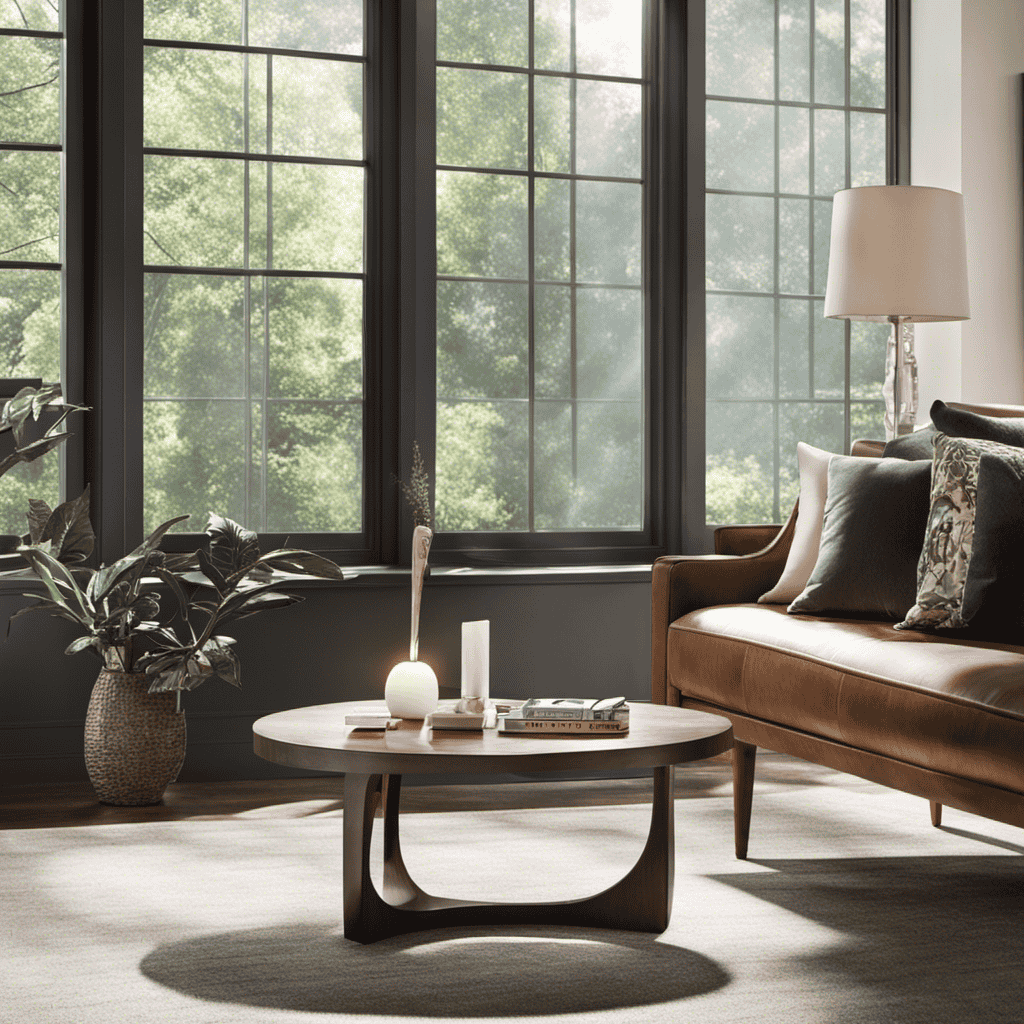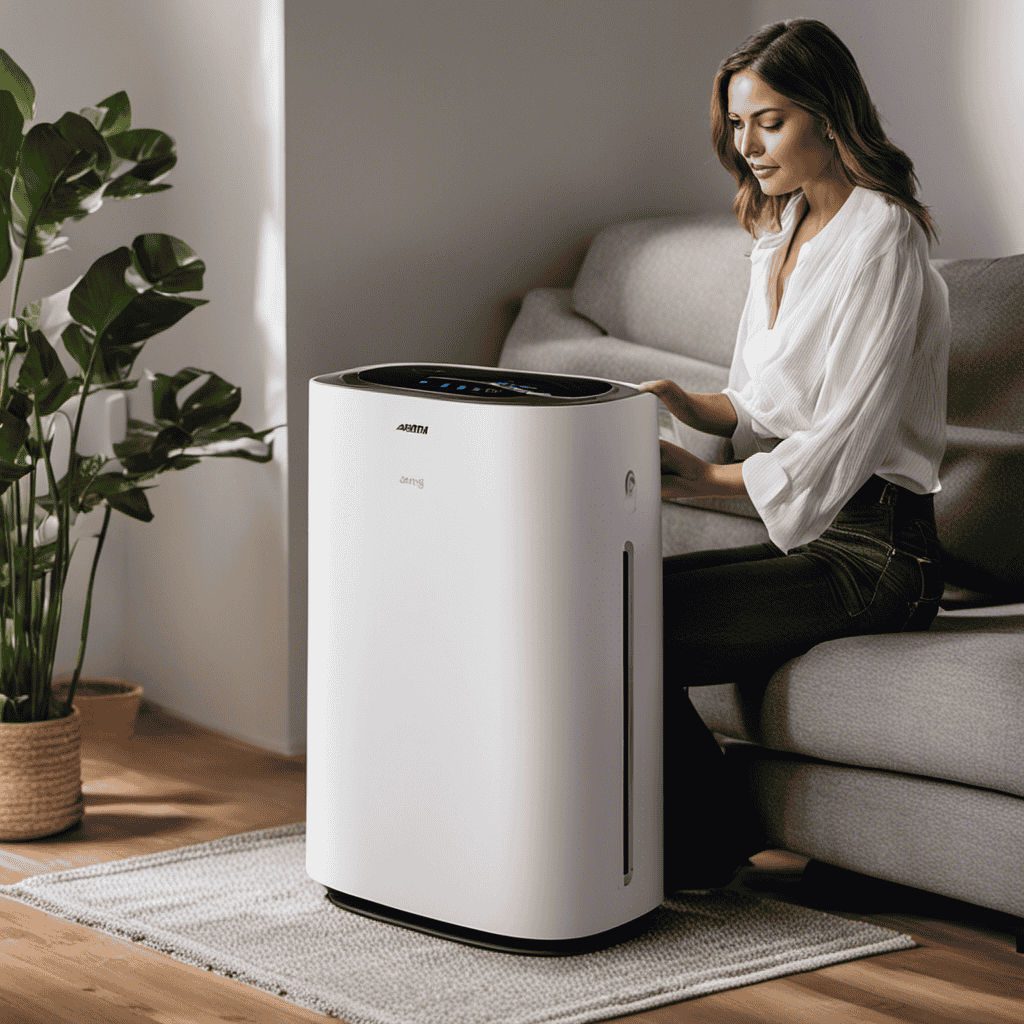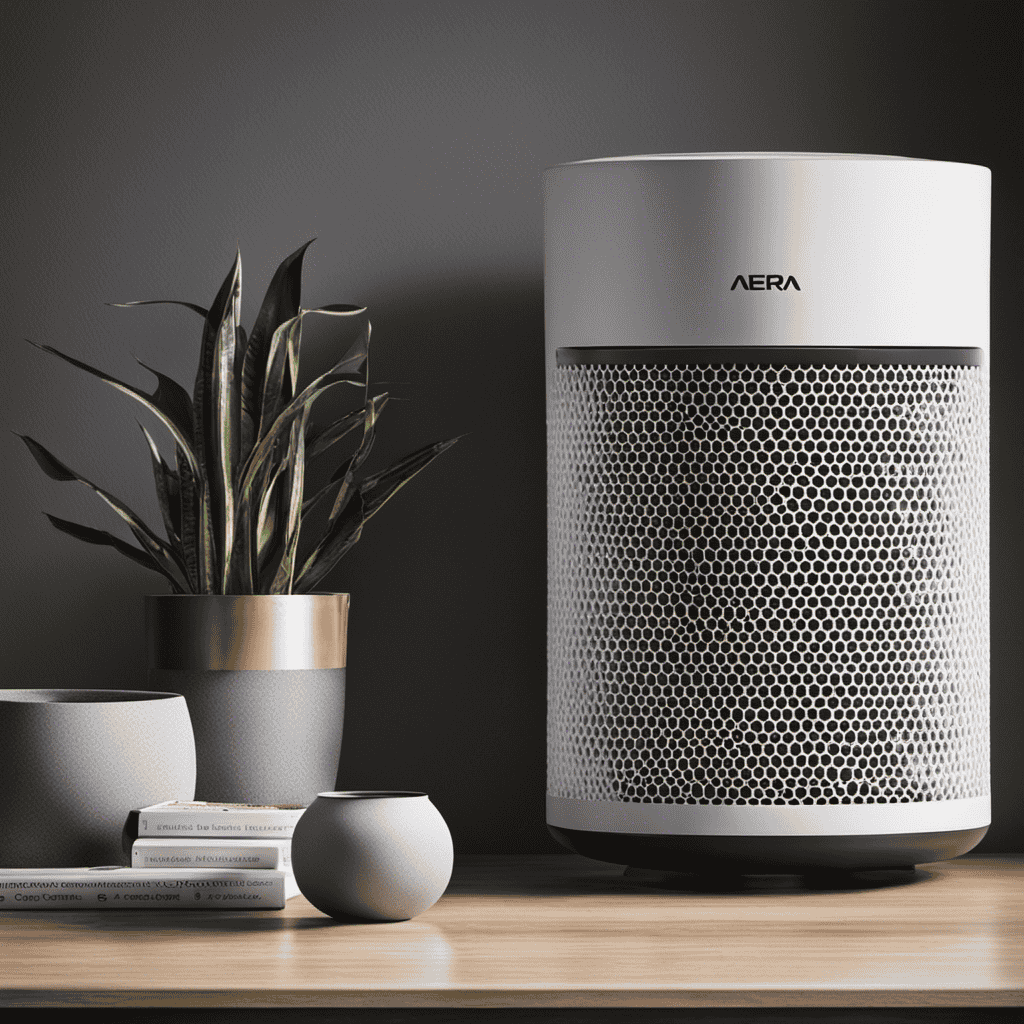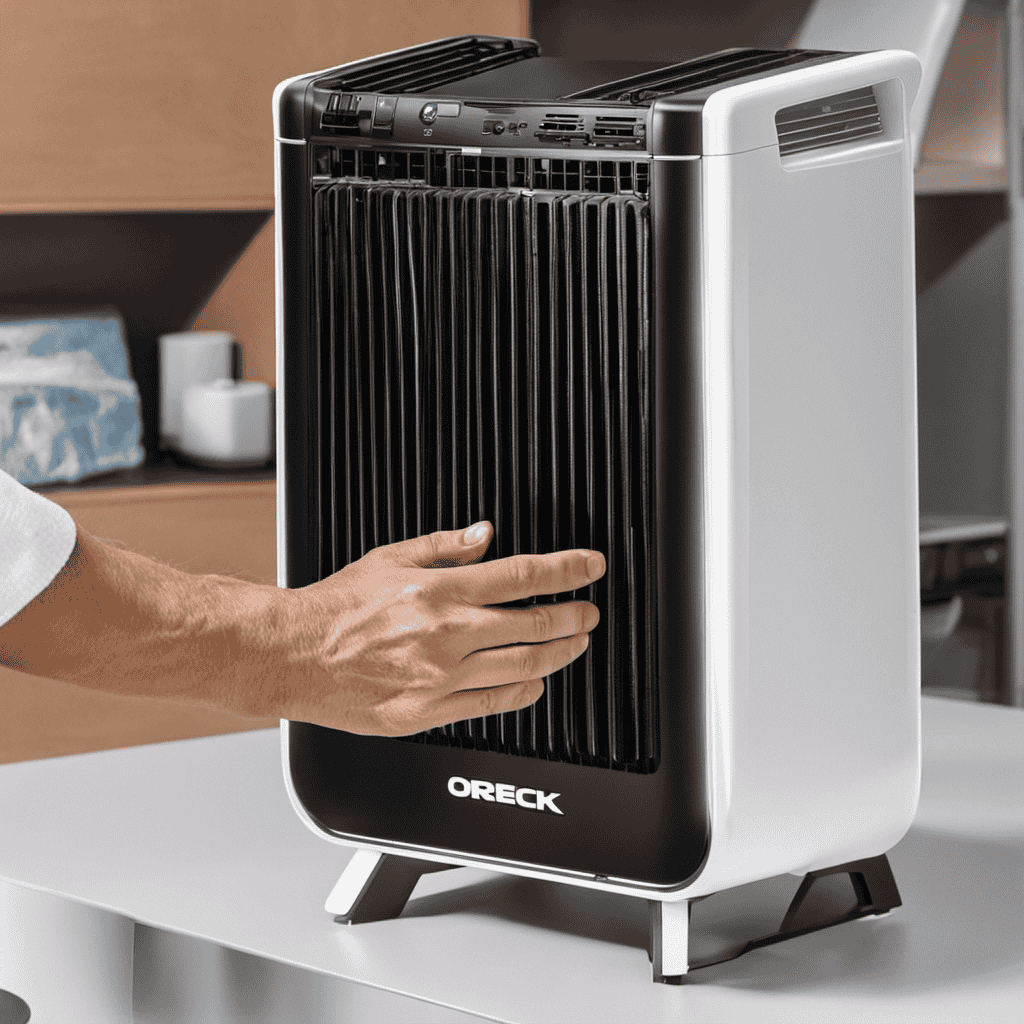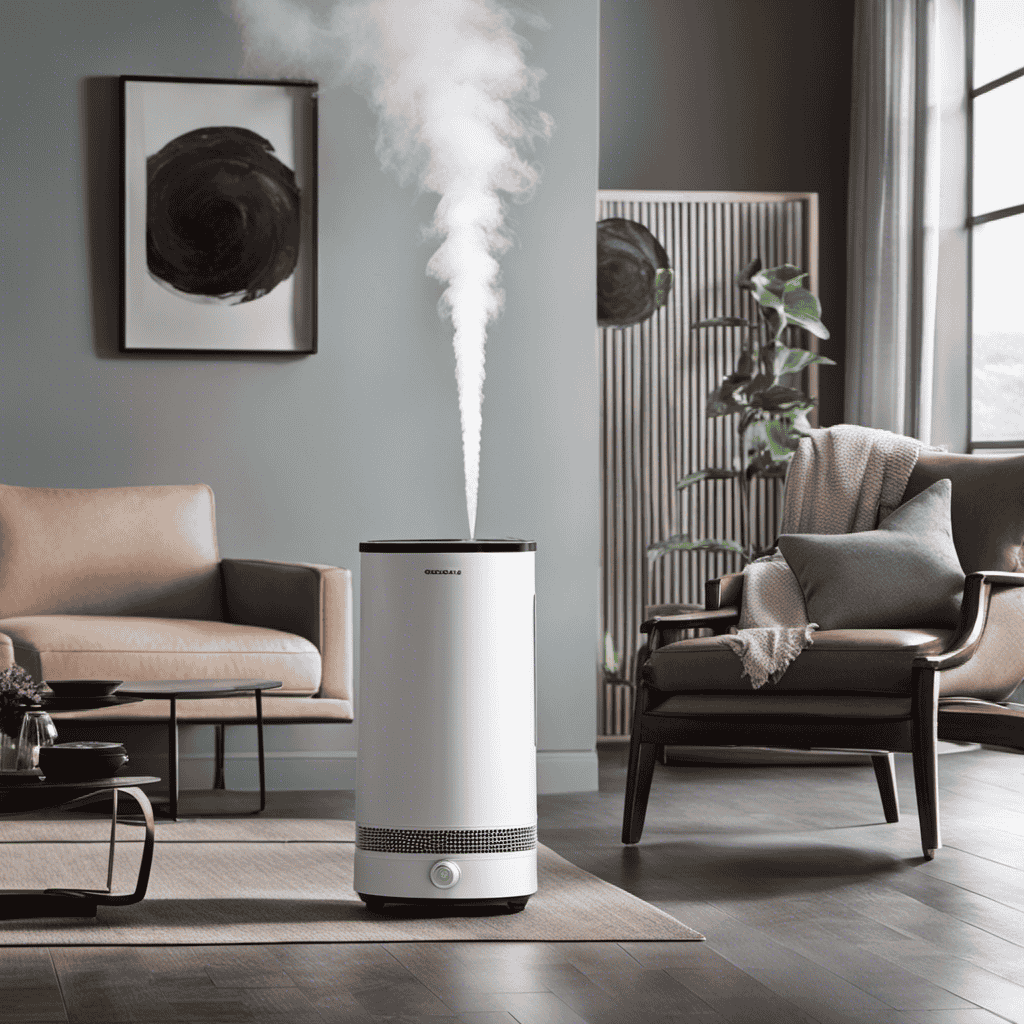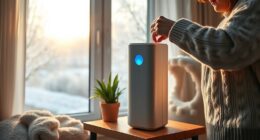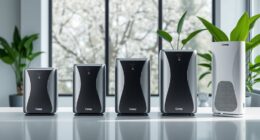I have always been curious about the optimal location to place an air purifier. Should it be in the bedroom or the living room? Is it more effective near the kitchen or close to the windows?
Well, after doing some research, I’ve discovered some evidence-based answers. In this article, I’ll share with you the ideal locations for placing an air purifier, including high-traffic areas, near sources of odors, and even by your HVAC system.
So, let’s dive in and find the perfect spot for cleaner, fresher air in your home.
Key Takeaways
- The bedroom is an ideal location for an air purifier to improve sleep quality and remove dust, pet dander, pollen, and allergens.
- In the living room, placing the air purifier near a window or door ensures proper air circulation, removes dust particles and odors, and reduces the presence of harmful volatile organic compounds (VOCs).
- The kitchen can benefit from an air purifier with a HEPA filter to improve air quality by capturing cooking fumes, smoke, and odors.
- For a home office, it is important to create a comfortable and organized workspace with proper ergonomics, lighting, and a quiet environment for optimal productivity.
Bedroom
You should place the air purifier in your bedroom to ensure clean and fresh air while you sleep.
Optimal air quality in the bedroom is crucial for sleep quality improvement. Dust, pet dander, pollen, and other allergens can accumulate in the bedroom, affecting the air you breathe and potentially disrupting your sleep.
An air purifier can help remove these particles from the air, creating a healthier sleep environment. Additionally, air purifiers often come with features like quiet operation and dimmed lights, ensuring they won’t disturb your sleep.
By placing an air purifier in your bedroom, you can enjoy a peaceful night’s rest knowing that you are breathing in clean and purified air.
Now let’s move on to the next section about the living room.
Living Room
The best spot for an air purifier in the living room would be near a window or door to allow for proper air circulation. This location ensures that the purifier can effectively filter out pollutants and allergens from the incoming fresh air. Placing it in the living room has several benefits, including optimal air filtration and improved indoor air quality.
Here are five reasons why having an air purifier in the living room is beneficial:
- Removes dust particles, pet dander, and pollen, providing relief for allergy sufferers.
- Eliminates odors from cooking, pets, or smoke, leaving the living room smelling fresh and clean.
- Reduces the presence of harmful volatile organic compounds (VOCs) emitted by household products and furniture.
- Helps maintain a healthy environment for children and elderly individuals who spend a significant amount of time in the living room.
- Creates a peaceful and relaxing atmosphere by reducing air pollution and improving overall air quality.
Having an air purifier in the living room not only enhances the aesthetic appeal but also promotes a healthier and more comfortable living space.
Kitchen
In the kitchen, it’s important to keep your countertops clean and free of food debris to prevent bacteria growth. However, maintaining a clean kitchen goes beyond just wiping down surfaces.
One aspect that is often overlooked is the air quality. The kitchen is a place where cooking fumes, smoke, and odors can linger, affecting the overall freshness of the space. To improve air quality in the kitchen, using an air purifier with an optimal filter is essential.
Look for air purifiers that have a HEPA filter, which can effectively capture and remove airborne particles such as dust, pollen, and even bacteria. Additionally, regular maintenance of the air purifier is crucial. Follow the manufacturer’s instructions for filter replacement and cleaning to ensure optimal performance.
Home Office
To improve the productivity of your home office, it’s essential to create a comfortable and organized workspace. Here are five key considerations to keep in mind:
-
Proper desk setup: Choose a desk that suits your needs and allows for proper ergonomics. Consider adjustable height options and ample workspace for your equipment and documents.
-
Comfortable seating: Invest in a supportive chair that promotes good posture and provides comfort during long hours of work.
-
Effective lighting: Ensure your workspace is well-lit to reduce eye strain and improve focus. Natural light is ideal, but if that’s not possible, opt for bright, adjustable artificial lighting.
-
Noise control: Minimize distractions by placing your home office in a quiet area of your house. If that’s not possible, consider using noise-cancelling headphones or a white noise machine to block out unwanted sounds.
-
Organizational systems: Keep your workspace tidy and organized with storage solutions like shelves, drawers, and file cabinets. This will help reduce clutter and improve efficiency.
Nursery
Set up a cozy and inviting nursery for your little one by choosing soft and soothing colors, comfortable furniture, and adorable decorations.
When creating a safe and healthy environment for your baby, it’s important to consider air quality. One way to improve air quality in the nursery is by using an air purifier.
To ensure effective air purification, it is crucial to choose the right air purifier and maintain it properly. Look for an air purifier that is specifically designed for nurseries and has a HEPA filter, which can capture small particles and allergens.
Additionally, regularly clean and replace the filter as recommended by the manufacturer to maintain optimal performance. By taking these steps, you can provide your baby with clean and fresh air in their nursery, promoting better sleep and overall well-being.
As we move on to the next section about the basement, let’s explore how to improve air quality in this often overlooked area of our homes.
Basement
When improving air quality in the basement, it’s essential to address moisture issues to prevent mold growth. Moisture can seep into the basement through cracks in the walls or floors, leading to a damp environment that is conducive to mold growth. By addressing these moisture issues, you can not only improve the air quality but also prevent potential health problems associated with mold exposure.
Here are five key things to consider when improving air quality in the basement:
- Install a dehumidifier to reduce excess moisture in the air.
- Seal any cracks or gaps in the walls or floors to prevent water intrusion.
- Use mold-resistant materials for flooring and walls to prevent mold growth.
- Ensure proper ventilation by opening windows or using exhaust fans.
- Regularly clean and maintain the basement to prevent dust and allergen buildup.
By following these steps, you can enjoy the potential benefits of improved air quality in your basement while dispelling common misconceptions about mold growth and moisture issues.
Now, let’s transition to the next section about improving air quality in the garage.
Garage
When it comes to optimizing the effectiveness of an air purifier in the garage, there are a few key points to consider.
First, it is important to determine the optimal placement for maximum coverage. This may involve strategically placing the air purifier near potential sources of pollutants, such as vehicles or storage items.
Second, it is crucial to be aware of the potential air pollutants present in the garage, which can include vehicle emissions, chemicals from stored items, and dust particles.
Lastly, in a space-constrained area like a garage, it is essential to consider the size and dimensions of the air purifier to ensure it fits properly and does not obstruct any necessary movement or storage.
Optimal Placement for Effectiveness
For optimal effectiveness, it’s important to place the air purifier in a central location within the room. This ensures that the purifier can efficiently circulate and filter the air in the entire space. When considering where to place your air purifier, keep in mind the following:
-
Noise levels: Avoid placing the air purifier near areas where you spend a lot of time, such as your bed or desk, to minimize any potential disruption caused by noise.
-
Energy consumption: Placing the air purifier away from direct sunlight or heat sources can help reduce its energy consumption, as it won’t have to work as hard to cool down or regulate its internal temperature.
By strategically placing your air purifier in a central location, you can maximize its performance and ensure that the air in the room is effectively purified.
Now, let’s discuss the potential air pollutants present in your environment.
Potential Air Pollutants Present
There are various potential air pollutants that may be present in your environment. These pollutants can have potential health effects and can significantly impact the air quality in your home or workplace. It is important to be aware of these pollutants and take necessary measures to minimize their presence.
Here is a table that lists some common air pollutants and their potential health effects:
| Air Pollutant | Potential Health Effects |
|---|---|
| Particulate Matter (PM) | Respiratory issues, cardiovascular problems |
| Volatile Organic Compounds (VOCs) | Eye, nose, and throat irritation, headaches |
| Carbon Monoxide (CO) | Headaches, dizziness, nausea |
| Nitrogen Dioxide (NO2) | Respiratory issues, increased risk of respiratory infections |
| Ozone (O3) | Breathing difficulties, lung damage |
It is important to note that air quality standards have been established to regulate the levels of these pollutants. By understanding the potential health effects and adhering to these standards, we can ensure a healthier and safer environment.
Consideration of Space Constraints
Although space may be limited, it’s crucial to consider the potential health effects of air pollutants. When determining where to place an air purifier, it’s important to prioritize ventilation requirements and natural light exposure. Here are some points to consider:
-
Ventilation requirements: Ensure that the air purifier is placed in an area with proper airflow. This will allow the purifier to effectively circulate and filter the air, reducing the concentration of pollutants.
-
Natural light exposure: Place the air purifier near a window or in a well-lit area. Natural light can help to kill certain bacteria and viruses, improving the overall air quality.
-
Avoiding obstructions: Keep the purifier away from furniture, curtains, or other objects that may obstruct the airflow.
-
Consider room size: Choose an air purifier that is suitable for the size of the room. A larger room may require a higher capacity purifier to effectively clean the air.
-
Noise considerations: If noise is a concern, place the air purifier in an area where it won’t disturb your activities or sleep.
Bathroom
When it comes to placing an air purifier in the bathroom, there are a few key suggestions to consider.
Firstly, it is important to find an optimal placement location that allows for maximum coverage and effectiveness.
Secondly, ventilation requirements should be taken into account to ensure proper airflow and circulation.
Lastly, there are numerous benefits to purifying the air in your bathroom, such as removing unpleasant odors, reducing mold and mildew growth, and improving overall air quality for a healthier environment.
Optimal Placement Suggestions
For the best air circulation, it’s recommended to place your air purifier in a central location within the room. This ensures that the purified air can reach all corners of the space effectively.
When considering where to place your air purifier, keep in mind the following suggestions:
-
Away from obstacles: Avoid placing the purifier behind furniture or near curtains, as these can obstruct the airflow.
-
Elevated position: Placing the purifier on a raised surface, such as a table or shelf, allows for better air intake and distribution.
-
Near the source: If there is a specific area in the room that tends to have more pollutants, such as near a pet’s bed or a smoking area, position the purifier nearby to target those contaminants.
-
Consider noise levels: Take into account the noise produced by the air purifier. If it’s a concern, avoid placing it directly beside your bed or workspace.
-
Maintenance requirements: Ensure easy access to the purifier for regular maintenance tasks like filter replacement or cleaning.
Consider Ventilation Requirements
To ensure proper airflow, it’s important to consider the ventilation requirements when determining the ideal location for your air purifier. Ventilation requirements play a crucial role in maintaining good air quality standards in any space.
When placing your air purifier, it’s essential to ensure that there is sufficient airflow to allow the unit to effectively remove pollutants from the air. This means placing the purifier in an area with adequate ventilation, such as near a window or a doorway. By doing so, you can ensure that the purified air is circulated properly throughout the room.
Neglecting ventilation requirements may hinder the performance of your air purifier and compromise the overall air quality.
Now, let’s dive into the benefits of bathroom purification.
Benefits of Bathroom Purification
One of the benefits of purifying your bathroom is that it helps to eliminate unpleasant odors. By using an air purifier specifically designed for bathrooms, you can improve the air quality and create a more pleasant environment. Here are some potential health benefits and ways in which purifying your bathroom can help with moisture control:
- Reducing the presence of mold and mildew, which can trigger allergies and respiratory issues.
- Eliminating bacteria and viruses that may be present in the air, reducing the risk of infections.
- Removing unpleasant odors caused by bacteria and other sources.
- Controlling humidity levels, preventing the growth of mold and mildew.
- Improving overall indoor air quality, which can have a positive impact on respiratory health.
Purifying your bathroom not only provides these benefits, but it also sets the stage for a clean and inviting space.
Transitioning into the subsequent section about the dining room, let’s explore how air purifiers can enhance the air quality in another important area of your home.
Dining Room
You should consider placing the air purifier in your dining room for optimal air quality. The dining room is often a central area in the home where the family gathers for meals and spends a significant amount of time. By placing the air purifier in this room, you can ensure that everyone benefits from clean and fresh air.
The dining room is also a great location for optimal air circulation, as it is usually a well-ventilated space. Additionally, dining rooms often have large windows, allowing for natural light exposure. This not only enhances the ambiance of the room but also helps to improve air quality.
So, don’t forget to place the air purifier in your dining room to create a healthier living environment for you and your family.
Now let’s move on to the next section, where we will discuss the importance of having an air purifier in the pet area.
Pet Area
If you have pets, it’s important to consider the cleanliness of their designated area. Not only does it help maintain a hygienic environment for your furry friends, but it also contributes to the overall air quality of your home.
When setting up a pet area, here are some key factors to consider for optimal air circulation and natural light exposure:
-
Positioning: Place the pet area in a well-ventilated area, away from direct sunlight to prevent overheating.
-
Airflow: Ensure there is ample space around the pet area for air to circulate freely, preventing stagnant air and potential odors.
-
Windows or Skylights: If possible, position the pet area near windows or install skylights to maximize natural light exposure, which can improve mood and help with vitamin D synthesis.
-
Avoid Carpet: Opt for easy-to-clean flooring like tiles or laminate, as carpet can trap pet dander and contribute to poor air quality.
-
Proper Cleaning: Regularly clean and disinfect the pet area to remove allergens, bacteria, and odors, ensuring a healthy environment for both you and your pets.
Allergy-Prone Areas
Having pets in allergy-prone areas can be challenging, but there are steps you can take to minimize allergens and create a healthier environment.
When it comes to bedroom placement, it’s important to keep your furry friends out of this space. Pets tend to shed dander, which can easily accumulate in the bedroom and trigger allergies. To ensure a restful night’s sleep, it’s best to keep pets out of the bedroom altogether.
Additionally, if you have a nursery, consider investing in an air purifier specifically designed for this area. These air purifiers are equipped with HEPA filters that can effectively remove allergens, such as pet dander and dust mites, from the air.
By taking these measures, you can create a safe and allergen-free space for you and your family.
Now, let’s move on to discussing how to address allergens in high-traffic areas.
High-Traffic Areas
When it comes to high-traffic areas, it’s important to regularly clean and vacuum to minimize allergens. These areas tend to accumulate more dust, dirt, and other pollutants, which can worsen allergies and respiratory conditions.
To ensure a clean and healthy environment, consider placing an air purifier in these spaces. Here are some bullet points to help you visualize the benefits:
-
Picture a bustling living room with constant foot traffic. An air purifier silently removes airborne allergens, like pet dander and pollen, providing relief for allergy sufferers.
-
Imagine a busy office space with people coming and going. The air purifier’s filters capture and trap dust particles, reducing the risk of respiratory issues.
-
Visualize a crowded kitchen where cooking odors linger. An air purifier with activated carbon filters can effectively eliminate unwanted smells.
-
Envision a playroom filled with energetic kids. The air purifier’s quiet operation won’t disturb their activities, ensuring clean air without disrupting playtime.
-
Think of a busy hallway or entrance area. An air purifier with adjustable fan speeds can be set to low during the day, minimizing noise while still purifying the air effectively.
Regular maintenance, such as replacing filters and cleaning the unit, is crucial for optimal performance and longevity. Additionally, choosing an air purifier with low noise levels ensures a peaceful atmosphere without sacrificing air quality.
Near Sources of Odors
Placing an air purifier near sources of odors is another important consideration when deciding where to place it in your home. Odors can come from a variety of sources, such as cooking, pets, or even dirty laundry. By placing the air purifier near these sources, you can effectively target and eliminate the odors. This can greatly improve the air quality in your home and create a more pleasant living environment.
When considering cost and maintenance requirements, it’s important to choose an air purifier that fits your budget and is easy to maintain. Different air purifiers have varying costs, depending on factors such as their size, features, and filtration technology. Additionally, some models may require more frequent filter replacements or maintenance than others. Therefore, it’s important to research and compare different options to find the best air purifier that meets your needs and budget.
Near Windows
When it comes to creating a healthy and comfortable living space, two key factors to consider are optimal air circulation and natural light exposure.
Proper air circulation is essential for maintaining a fresh and breathable environment, reducing the risk of airborne contaminants and improving overall indoor air quality.
Additionally, natural light exposure not only brightens up a room but also offers a range of health benefits such as boosting mood, increasing productivity, and regulating our internal body clock.
Optimal Air Circulation
To ensure optimal air circulation, it’s important to place the air purifier in a central location within the room. This allows the purifier to effectively reach all corners and areas, ensuring that the air is thoroughly filtered.
Here are some key points to consider when placing your air purifier:
- Distance from walls: Keep the purifier at least a foot away from walls to allow for proper air intake and circulation.
- Avoid obstructions: Place the purifier away from furniture, curtains, or any other objects that may obstruct the airflow.
- Elevation: Position the purifier at a higher level, such as a table or shelf, to maximize its coverage and efficiency.
- Room size: Consider the size of the room when determining the placement. Larger rooms may require multiple purifiers for optimal air purification.
- Noise reduction: If noise is a concern, place the purifier in an area where it won’t disrupt your activities or sleep.
By following these guidelines, you can ensure that your air purifier operates effectively and efficiently.
Now, let’s move on to the next important aspect of creating a healthy indoor environment: natural light exposure.
Natural Light Exposure
For optimal health benefits, it’s important to ensure that you have enough natural light exposure in your indoor environment. Natural light offers a wide range of benefits. It can improve your mood, boost your vitamin D levels, and regulate your sleep patterns. Sunlight exposure can even help alleviate symptoms of seasonal affective disorder (SAD) and improve your overall mental well-being.
To maximize your natural light intake, it’s essential to position your furniture and workspaces near windows. This way, you can make the most of the available sunlight. It’s also a good idea to keep your curtains or blinds open during the day, allowing sunlight to filter into your space.
If your indoor area lacks sufficient natural light, there are alternatives you can consider. One option is to use daylight bulbs that mimic the spectrum of natural light. These bulbs can help create a similar lighting environment, even when sunlight is limited.
Additionally, spending time outdoors, especially in the morning, can provide you with the necessary sunlight exposure for optimal health and well-being. So, make it a habit to get outside and soak up some natural light whenever you can.
Near HVAC System
Placing an air purifier near the HVAC system can help improve indoor air quality. Here are some potential benefits and maintenance tips:
-
Increased filtration efficiency: By positioning the air purifier near the HVAC system, it can capture airborne particles before they are distributed throughout the house, resulting in cleaner air.
-
Reduced allergens and pollutants: With the air purifier working in tandem with the HVAC system, it can effectively remove allergens like pollen, dust mites, and pet dander, as well as pollutants such as smoke and volatile organic compounds (VOCs).
-
Enhanced circulation: By placing the air purifier near the HVAC system’s intake, it can help improve air circulation, ensuring that the purified air is evenly distributed throughout the space.
-
Easy access for maintenance: Having the air purifier near the HVAC system makes it convenient for regular maintenance tasks like replacing filters and cleaning.
-
Cost-effective solution: When the air purifier works in conjunction with the HVAC system, it can help extend the lifespan of the HVAC filters, potentially saving on maintenance and replacement costs.
Remember to consult the manufacturer’s instructions for specific maintenance guidelines and regularly clean or replace filters to ensure optimal performance.
Placing an air purifier near the HVAC system can significantly contribute to a healthier indoor environment.
Is There a Specific Location for Placing an Air Purifier for Maximum Effectiveness?
When considering the best air purifier placement locations, it’s important to place the unit in a central area of the room to ensure maximum effectiveness. Avoid placing it near walls or furniture to allow for proper airflow. Additionally, aim to keep it away from direct sunlight and moisture-prone areas for optimal performance.
Frequently Asked Questions
Can an Air Purifier Be Used in a Car or Other Vehicles?
Yes, an air purifier can be used in a car or other vehicles. When using an air purifier in an airplane or car, it is important to choose the right one that suits your needs and vehicle size.
Is It Safe to Place an Air Purifier Near a Fireplace or Wood-Burning Stove?
Placing an air purifier near a fireplace or wood-burning stove may not be safe due to the potential for flames or sparks. Additionally, it’s important to avoid placing it near kitchen appliances or in areas with high humidity to prevent damage.
What Should Be the Ideal Distance Between an Air Purifier and an Electrical Outlet?
The ideal distance between an air purifier and an electrical outlet depends on the manufacturer’s recommendations. It’s important to follow these guidelines to ensure safety and proper functioning of the device.
Can an Air Purifier Help With Removing Pet Dander From Furniture and Carpets?
Yes, an air purifier can help remove pet dander from furniture and carpets. It’s like a superhero for allergies, trapping allergens and keeping the air clean for pet owners.
Are There Any Specific Considerations When Placing an Air Purifier in a Home With a Smoker?
When placing an air purifier in a home with a smoker, it’s important to consider the size of the room and the purifier’s coverage area. Additionally, positioning it near the source of smoke can help maximize its effectiveness in filtering out harmful particles.
Conclusion
After carefully considering the best placement for an air purifier, it is clear that strategic positioning can greatly enhance its effectiveness.
Placing an air purifier in the bedroom ensures clean and fresh air for a restful sleep.
In the living room, it helps combat pollutants from furniture and carpets.
The kitchen benefits from an air purifier near cooking areas to eliminate odors and harmful particles.
A home office can benefit from improved air quality for increased productivity.
In the nursery, an air purifier can promote a healthy environment for the little ones.
Additionally, high-traffic areas should have purifiers to remove dust and allergens.
Consider placing one near sources of odors, such as garbage cans or pet areas, for a fresher home.
Near windows, air purifiers can capture outdoor pollutants before they enter the house.
Lastly, positioning it near the HVAC system maximizes its efficiency.
With these considerations in mind, where will you place your air purifier to optimize its performance and enhance the quality of the air you breathe?
